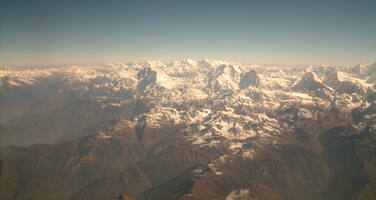Sagarmatha National Park
Factors affecting the property in 1998*
- Impacts of tourism / visitor / recreation
- Management systems/ management plan
- Other Threats:
Growing energy demands of the tourist industry
Factors* affecting the property identified in previous reports
- Impacts of tourism / visitor / recreation
- Management systems/ management plan
- Growing energy demands of the tourist industry
International Assistance: requests for the property until 1998
Total amount approved : 216,895 USD
| 1998 | Upgrading of interpretation displays and visitor ... (Approved) | 15,000 USD |
| 1983 | Reafforestation programme, improvement of the display ... (Approved) | 10,000 USD |
| 1982 | Specialist services of an energy adviser and financial ... (Approved) | 61,995 USD |
| 1981 | Financial contribution and specialist services for a ... (Approved) | 54,900 USD |
| 1980 | Energy adviser, equipment and financial assistance for ... (Approved) | 75,000 USD |
Missions to the property until 1998**
Conservation issues presented to the World Heritage Committee in 1998
At its twenty-first session, the Bureau noted that supplying the energy needs of the growing number of tourists, staff and the Sherpa community is the most critical management issue in this site. At present, site staff and a considerable number of the Sherpa families resident in lower elevations have shifted to the use of kerosene and micro-power plants to meet their energy needs. However, tourist installations in the higher alpine zones continue to exploit the juniper bushes to meet their fuel-wood needs. The site management is initiating a project for which the Chairperson, based on a request submitted by the State Party, approved a sum of US$ 15,000 from the Fund, to update information-displays at the interpretation Centre at the Park entrance and in the Namche Bazar Visitor Centre. New displays are to be designed in order to inform visitors of the growing energy demands of the tourist industry and to suggest possible ways and means by which tourists could help the management to find solutions. Restrictions to the number of visitors to the Park is likely to be resisted by the Sherpa community who derive about 75% of their income from tourism; at least one member of each Sherpa household is employed in the tourism industry. The site management intends to start a process for revising the management plan of the site, in connection with the commemoration of the site’s 25th anniversary in 2001. As part of that process detailed analyses of trends in the growth in the numbers of visitors and local population and associated energy demands will be undertaken.
IUCN informed the Bureau about a seminar held on the Impacts of Tourism Development on Sagarmatha in August 1998. A research project to revise the management plan, prepare a tourism development strategy and undertake relevant training is also under consideration by protected landscape and development agencies of the United Kingdom.
The Bureau encouraged the State Party to seek a long-term, strategic approach for managing the increase in the growth of the numbers of visitors and local people and the parallel rise in energy demands. The Bureau requested the Centre and IUCN Nepal to co-operate with the State Party and the relevant agencies of the United Kingdom to ensure that visitor rates, tourism infrastructures development and energy demand planning become an integral part of the process to revise the site’s management plan in connection with the commemoration of Sagarmatha’s 25th anniversary in 2001.
Summary of the interventions
Decisions adopted by the Committee in 1998
22 COM VII.27
Reports on the State of Conservation of Natural Properties Noted by the Committee
VII.27 The Committee noted the decisions of the twenty-second extraordinary session of the Bureau as reflected in the Report of the Bureau session (Working Document WHC-98/CONF.203/5) and included in Annex IV on the following properties:
- Heard and McDonald Islands (Australia)
- Shark Bay, Western Australia (Australia)
- Wet Tropics of Queensland (Australia)
- Belovezhskaya Pushcha/Bialowieza Forest (Belarus/Poland)
- Iguacu National Park (Brazil)
- Dja Faunal Reserve (Cameroon)
- Canadian Rocky Mountain Parks (Canada)
- Jiuzhaigou Valley Scenic and Historic Interest Area (China)
- Huanglong Scenic and Historic Interest Area (China)
- Wulingyuan Scenic and Historic Interest Area (China)
- Los Katios National Park (Colombia)
- Morne Trois Pitons National Park (Dominica)
- Nanda Devi National Park (India)
- Whale Sanctuary of El Viscaino (Mexico)
- Royal Chitwan National Park (Nepal)
- Sagarmatha National Park (Nepal)
- Arabian Oryx Sanctuary (Oman)
- Huascaran National Park (Peru)
The Committee noted that the Bureau's decision reflected the suggestion to establish an informal contact group on mining and World Heritage and that the IUCN "Draft Policy on Mining and Protected Areas" will be circulated.
- Kamchatka Volcanoes (Russian Federation)
- Virgin Komi Forests (Russian Federation)
- Skocjan Caves (Slovenia)
- Thung Yai-Huay Kha Khaeng Wildlife Sanctuaries (Thailand)
- St. Kilda (United Kingdom)
- Ha Long Bay (Vietnam)
- Durmitor National Park (Federal Republic of Yugoslavia)
The Committee noted the UN official name for the State Party: Federal Republic of Yugoslavia.
- Mosi-oa-Tunya/Victoria Falls (Zambia/Zimbabwe)
No draft Decision
* :
The threats indicated are listed in alphabetical order; their order does not constitute a classification according to the importance of their impact on the property.
Furthermore, they are presented irrespective of the type of threat faced by the property, i.e. with specific and proven imminent danger (“ascertained danger”) or with threats which could have deleterious effects on the property’s Outstanding Universal Value (“potential danger”).
** : All mission reports are not always available electronically.


